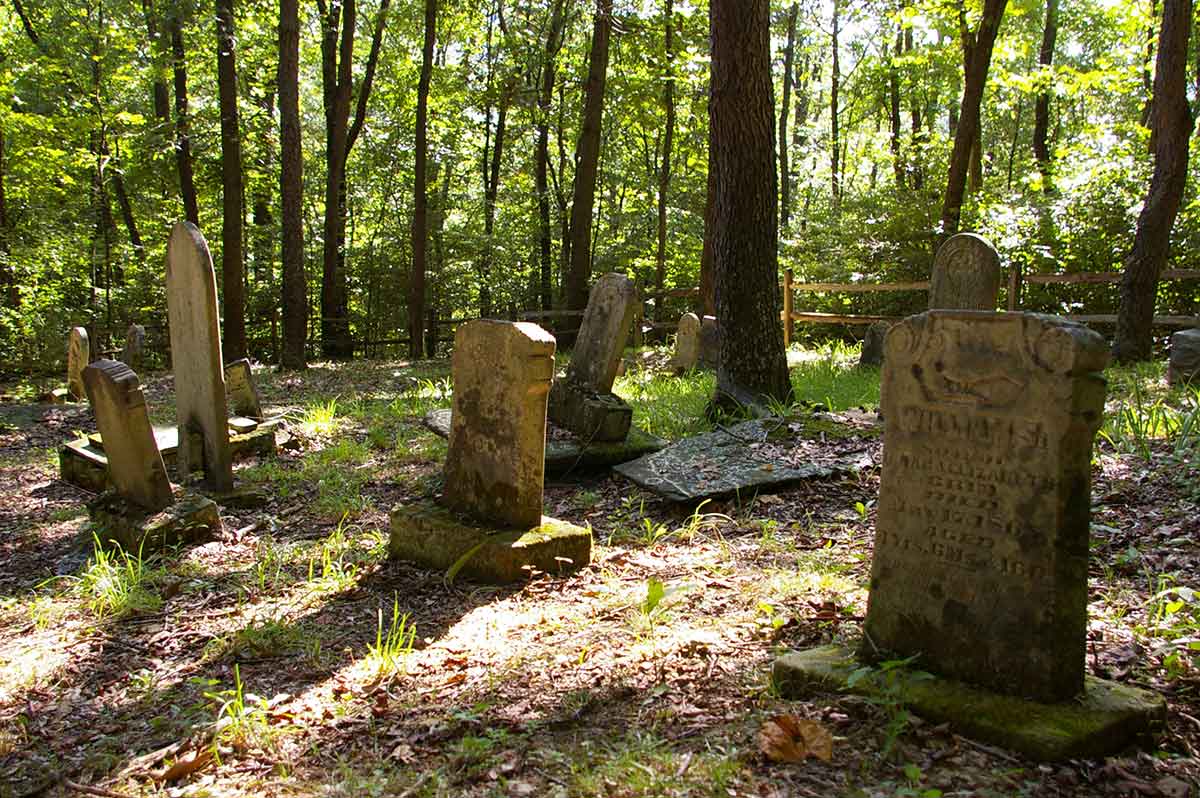
Old cemeteries found in the woods, like this one at Pennsylvania’s Ryerson Station State Park, add interest to hikes.
Bob Frye/Everybody Adventures
There are two seeming miracles here, really.
The first is that the Chess family found ground flat enough – even relatively speaking – to build a cemetery.
We were hiking in extreme southwestern Pennsylvania, fewer than a dozen miles from the border of the West Virginia panhandle. It’s a land of coal and sheep and woods.
And it is, in a word, wrinkly.
There are no mountains here, per se. The highest point in Greene County is about 1,660 feet above sea level. That’s half as high as the state’s tallest peak.
But the landscape resembles nothing so much as an unending series of waves, one following close behind another.
Each narrow ridgeline lies near another, but separated by an equally skinny, and steep, gully.
“Severe” is how one map describes the landscape, and it feels it hiking up and then descending hill after hill after hill.
It hardly seems ideal for burying the dead.
The second miracle is that the Chess cemetery still exists and in such relatively good shape.
The first people buried here – so far as you can tell; some stones are worn smooth – died in 1834. The last passed in 1907. But most of the gravestones date to the mid-1800s.
They lie on public land these days. The cemetery is now a part of Ryerson Station State Park.
The state didn’t start buying land for the park until 1958, though. So the cemetery survived at least half a century on its own before that.
Did descents of the families buried there maintain it? Or some cemetery association? Or did it just kind of hang on, known but not necessarily cared for?
I can’t find any information one way or the other.
But one thing’s clear: spend enough time hiking and, sooner or later, you’ll come across old cemeteries. They dot public lands all over the country.
Some, like at Ryerson, are well kept. Others, not so much.
There’s one piece of public land I hunt and hike in another area that contains at least two cemeteries. One sits in a field, along a woodline, and gets regularly mowed. A sign on the iron fence around it identifies it by name.
Yet another, maybe four or five miles away as the crow flies, sits fairly hidden in an ever-aging forest. It, too, has a fence around it, though this one’s only shin tall. Its headstones are tiny – most the size of a hardcover textbook, if that – and the writing on them faint. A few have metal insignias indicating the presence of veterans.
No one maintains it. It is, by comparison, forgotten. Whether that’s a matter of access or knowledge or what, I can’t say.
But I love to explore such places and think of the people buried there. What joys they felt, what sorrows.
There were surely plenty of the latter.
In a place and time when people were literally hacking a life out of rugged country, sometimes welcomed by the natives there before them and sometimes not, so many people died young. The graves of children ages 2 and 3 and 4 are common.
And those are only the graves we know of.
Some estimates say there are more than 25,000 cemeteries in the United States. That total doesn’t necessarily include those considered, officially or not, abandoned, though.
You can find, too, lists of the “oldest” cemetery in each state. But those often take into consideration only those that remain.
For centuries before European settlement, and a couple more centuries after, cemeteries were little more than family burial plots. Markers were often temporary or at best the kind of field stones that, in time, lost their significance.
So keep an eye out the next time you’re wandering the woods, hiking staff in hand. You may just come across the marked final resting place of a pioneer family living a hardscrabble life.
They’re miracles of a sort.
Look for more around cemeteries
The cemeteries you find deep in the woods are interesting in and of themselves.
But sometimes they’re also clues.
The oldest, smallest cemeteries were often family affairs. So, with a little respectful exploring around one, you may find the remnants of old foundations, from homes, barns and springhouses.
Look, too, for retaining walls. Sometimes built around cemeteries for aesthetic as well as erosion control reasons, they offer hints about craftsmanship and available materials.
Finally, pay attention to the trees around the burial plot.
Chances are the graveyard wasn’t originally plotted in a thick forest. More likely it was a field or open space of some kind.
So if there are towering oaks or other trees around it – perhaps of about the same age as the headstones – you might be able to figure out the original layout of the cemetery.
MORE FROM EVERYBODY ADVENTURES
See also: Ruins among the most memorable parts of some hikes
Follow us on Facebook, Twitter and Instagram.








